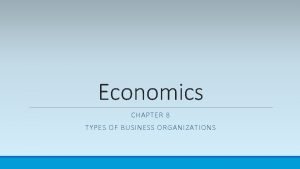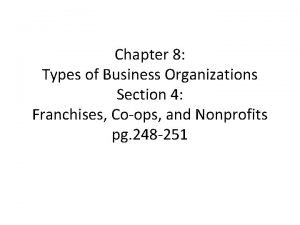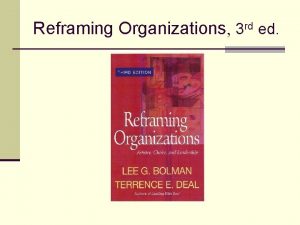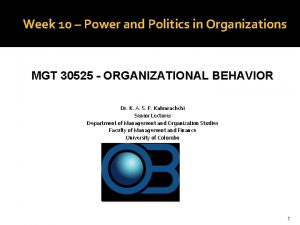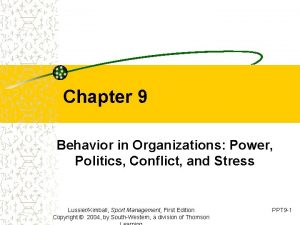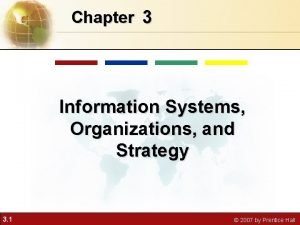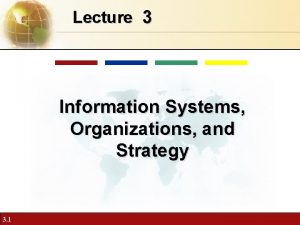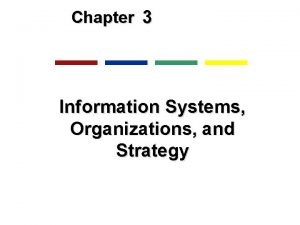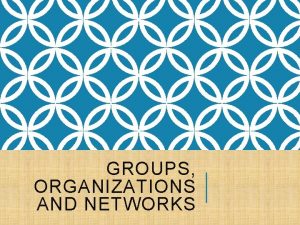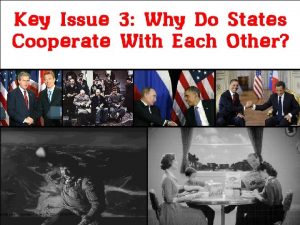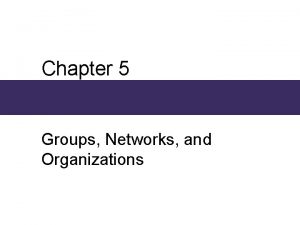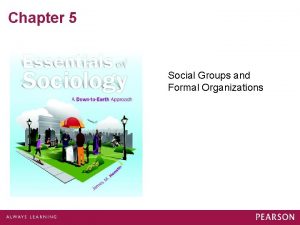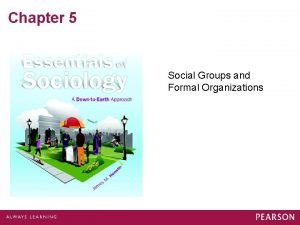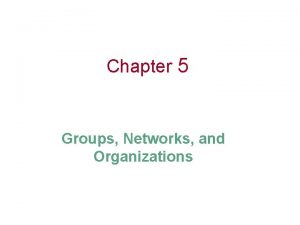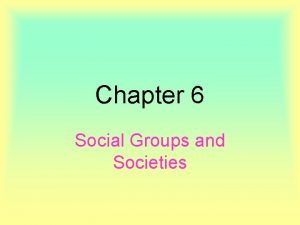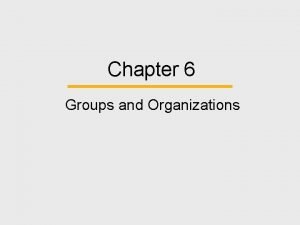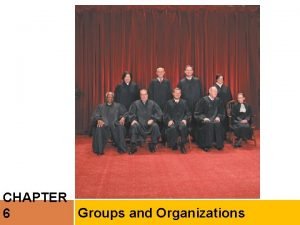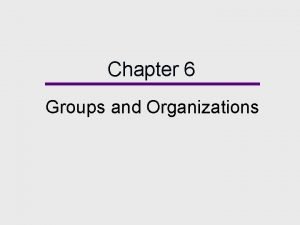Groups Networks and Organizations Chapter 6 Groups Networks



























- Slides: 27

Groups, Networks, and Organizations Chapter 6

Groups, Networks, and Organizations • Military discipline at West Point Academy is most heavily dependent on: – (a) fear of punishment by superiors. – (b) positive reinforcement from superiors. – (c) group loyalty and conformity to social norms. – (d) personal motivation and self-discipline. 2

Basic Concepts 3

Basic Concepts • Social Group – A collection of people who regularly interact with one another on the basis of shared expectations about behavior and who share a sense of a common identity 4

Basic Concepts • Social Group – Not a social aggregate – Not a social category 5

Basic Concepts 6

Basic Concepts • Primary groups – Friendships, families • Secondary groups – Sports teams, workplace, college classroom 7

Basic Concepts • Conformity – Asch’s research on groups and conformity 8

Basic Concepts • Conformity – Milgram’s research on obedience and authority 9

Basic Concepts • Organizations – An identifiable membership that engages in concerted collective actions to achieve a common purpose – usually large secondary groups with much more complex sets of relationships and divisions of labor than are typically found in a social group. 10

Basic Concepts • Formal Organizations – Rationally designed to achieve its objectives, often by means of explicit rules, regulations, and procedures – Dominant form of organization around the world – Bureaucracy – Schools and universities, hospitals, chain stores, government, sports teams, churches and synagogues, and corporations 11

Basic Concepts • Networks – Sets of informal and formal ties that link people to each other – Networks may be connected to social groups, but not all members of the network are in the social group 12

Theories of Groups, Organizations, and Networks 13

Theories of Groups, Organizations, and Networks • In-Groups – “us” – loyalty and respect • Out-Groups – “those people” – antagonism and contempt 14

Theories of Groups, Organizations, and Networks • Reference Groups 15

Theories of Groups, Organizations, and Networks • The Effects of Size – Dyads-unstable and intense due to size – Triads-could form coalitions – Larger groups – Organizations 16

Theories of Groups, Organizations, and Networks 17

Theories of Groups, Organizations, and Networks • Bureaucracy – The dominant form of formal organization around the world. – Most efficient way of accomplishing goals in modern society. 18

Theories of Groups, Organizations, and Networks • Characteristics of bureaucracy – – Hierarchy of authority Written rules/roles Paid positions based on skills and/or seniority Work in the organization is impersonal and physically separated from home life – Workers do not own the work they do or the resources used to perform it 19

Theories of Groups, Organizations, and Networks • Relations in bureaucracies – Formal relations • Behavior guided by formal rules and subject to formal authority – Informal relations • Ways of doing things that depart from formally recognized modes of procedure 20

Theories of Groups, Organizations, and Networks • Bureaucracies maintain power through the control of time and space Timetables • regularize activities across time and space Surveillance • Supervising activities of individuals or groups to ensure compliant behavior 21

Theories of Groups, Organizations, and Networks • Surveillance in organizations – Direct supervision – Keeping paper and computer files 22

Theories of Groups, Organizations, and Networks • The Strength of Weak Ties (Mark Granovetter) – Strong ties • Close friends and family – Weak ties • Distant relatives or remote acquaintances 23

Contemporary Research on Groups and Networks 24

Contemporary Research on Groups and Networks • George Ritzer’s The Mc. Donaldization of Society four guiding principles – Efficient methods for accomplishing tasks • Fastest way from point A to point B – Calculability • Quantity over quality – Uniformity • Predictability and standardization 25

Contemporary Research on Groups and Networks • George Ritzer’s The Mc. Donaldization of Society – Control through automation • Workers replaced by machines 26

Contemporary Research on Groups and Networks • The Internet as Social Network – Fosters creation of relationships • Expression of intimate feelings suppressed in face-to-face encounters • Can strengthen bonds • Access to organizations • Although there are still inequalities 27
 Formal groups fulfill both and functions in organizations.
Formal groups fulfill both and functions in organizations. Social groups and formal organizations
Social groups and formal organizations Introduction to management and organizations
Introduction to management and organizations Chapter 3 information systems organizations and strategy
Chapter 3 information systems organizations and strategy Packet switching datagram and virtual circuit approach
Packet switching datagram and virtual circuit approach How are ethnic groups and religious groups related
How are ethnic groups and religious groups related Chapter 8 types of business organizations
Chapter 8 types of business organizations Chapter 8 section 4
Chapter 8 section 4 Chapter 8 business organizations
Chapter 8 business organizations Reframing organizations chapter 3 summary
Reframing organizations chapter 3 summary Chapter 3 business organizations
Chapter 3 business organizations Backbone networks in computer networks
Backbone networks in computer networks Power and politics in organizations
Power and politics in organizations Vhwo
Vhwo Compare and contrast business organizations
Compare and contrast business organizations Persuasive communication
Persuasive communication Power, politics and conflict in organizations
Power, politics and conflict in organizations Perceiving ourselves and others in organizations
Perceiving ourselves and others in organizations Csusm clubs and organizations
Csusm clubs and organizations Power, politics and conflict in organizations
Power, politics and conflict in organizations Physical property of ammonia
Physical property of ammonia Inventing and reinventing organizations
Inventing and reinventing organizations Information systems, organizations, and strategy
Information systems, organizations, and strategy Information systems, organizations, and strategy
Information systems, organizations, and strategy Information systems, organizations, and strategy
Information systems, organizations, and strategy Cultures and organizations software of the mind
Cultures and organizations software of the mind Information systems organizations and strategy
Information systems organizations and strategy Youth organizations in great britain
Youth organizations in great britain






